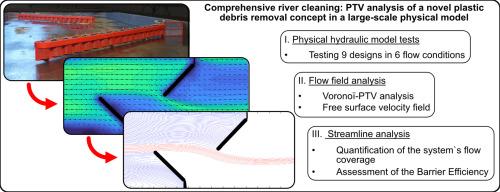Comprehensive river cleaning: PTV analysis of a novel plastic debris removal concept in a large-scale physical model
IF 12.4
1区 环境科学与生态学
Q1 ENGINEERING, ENVIRONMENTAL
引用次数: 0
Abstract
Plastic pollution in rivers represents a significant environmental threat, particularly in small- and medium-sized urban rivers, which account for major global riverine plastic emissions. This necessitates developing and optimizing effective countermeasures. However, limited research on existing clean-up technologies, precisely their plastic removal capabilities and hydraulic impacts on river systems, makes selecting and properly designing effective plastic removal measures challenging. This study evaluates a patented technology for river-wide plastic debris removal, which uses rotating screen drums mounted on groyne-like structures along the riverbanks. We tested the technology in a hydraulic model under 54 different flow and operational conditions representing tidal-influenced, low-gradient rivers with discharges of 17 m³/s - 115 m³/s. Particle Tracking Velocimetry (PTV) was used to analyze the 2D-horizontal flow field around the cleaning modules and to identify distinct flow regions and shear layers around the system. The resulting flow fields and vectors provide insights into the system's hydraulic impacts on the flow dynamics within the river stretch. Streamlines were calculated to assess the system's cleaning performance and macroplastic removal ability across the entire river width for different tested configurations. Hydraulic model tests demonstrated that the system's width-related barrier efficiency varies from 85 % to 100 %, depending on the chosen design parameters. The tested modular system achieves full efficiency while maintaining ecological corridors (fish/sediment passage) and ship passage in the reproduced medium-sized prototype river of 50 m width. Our study developed a robust methodology based on PTV measurements for evaluating both cleaning performance and hydraulic impact, which can be applied to a wide range of river clean-up technologies and applications. This study enhances understanding of flow-interaction in macroplastic-polluted rivers and may support effective river management and restoration by optimizing clean-up measures.


综合河流清洁:大型物理模型中新型塑料碎片去除概念的PTV分析
河流中的塑料污染是一个重大的环境威胁,特别是在中小型城市河流中,这些河流占全球河流塑料排放的主要来源。这就需要制定和优化有效的对策。然而,由于对现有清理技术的研究有限,特别是对其塑料去除能力和对河流系统的水力影响,使得选择和适当设计有效的塑料去除措施具有挑战性。这项研究评估了一项用于清除河面塑料垃圾的专利技术,该技术使用沿河岸安装在类似石坝的结构上的旋转筛鼓。我们在54种不同流量和操作条件下的水力模型中测试了该技术,这些条件代表了受潮汐影响的低梯度河流,流量为17 m³/s - 115 m³/s。采用粒子跟踪测速技术(PTV)对清洗模块周围的二维水平流场进行分析,识别出系统周围不同的流动区域和剪切层。由此产生的流场和矢量可以深入了解系统对河段内流动动力学的水力影响。计算了流线,以评估系统在不同测试配置下的清洗性能和整个河流宽度的宏观塑性去除能力。水力模型试验表明,根据所选择的设计参数,该系统与宽度相关的屏障效率从85%到100%不等。经过测试的模块化系统在保持生态廊道(鱼/沉积物通道)和船舶通道的同时,在50米宽的中型原型河中实现了充分的效率。我们的研究开发了一种基于PTV测量的可靠方法,用于评估清洁性能和水力影响,可应用于广泛的河流清洁技术和应用。该研究增强了对宏观塑料污染河流流动相互作用的理解,并可能通过优化清理措施来支持有效的河流管理和恢复。
本文章由计算机程序翻译,如有差异,请以英文原文为准。
求助全文
约1分钟内获得全文
求助全文
来源期刊

Water Research
环境科学-工程:环境
CiteScore
20.80
自引率
9.40%
发文量
1307
审稿时长
38 days
期刊介绍:
Water Research, along with its open access companion journal Water Research X, serves as a platform for publishing original research papers covering various aspects of the science and technology related to the anthropogenic water cycle, water quality, and its management worldwide. The audience targeted by the journal comprises biologists, chemical engineers, chemists, civil engineers, environmental engineers, limnologists, and microbiologists. The scope of the journal include:
•Treatment processes for water and wastewaters (municipal, agricultural, industrial, and on-site treatment), including resource recovery and residuals management;
•Urban hydrology including sewer systems, stormwater management, and green infrastructure;
•Drinking water treatment and distribution;
•Potable and non-potable water reuse;
•Sanitation, public health, and risk assessment;
•Anaerobic digestion, solid and hazardous waste management, including source characterization and the effects and control of leachates and gaseous emissions;
•Contaminants (chemical, microbial, anthropogenic particles such as nanoparticles or microplastics) and related water quality sensing, monitoring, fate, and assessment;
•Anthropogenic impacts on inland, tidal, coastal and urban waters, focusing on surface and ground waters, and point and non-point sources of pollution;
•Environmental restoration, linked to surface water, groundwater and groundwater remediation;
•Analysis of the interfaces between sediments and water, and between water and atmosphere, focusing specifically on anthropogenic impacts;
•Mathematical modelling, systems analysis, machine learning, and beneficial use of big data related to the anthropogenic water cycle;
•Socio-economic, policy, and regulations studies.
 求助内容:
求助内容: 应助结果提醒方式:
应助结果提醒方式:


